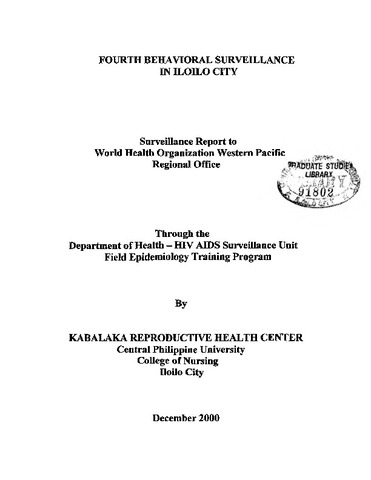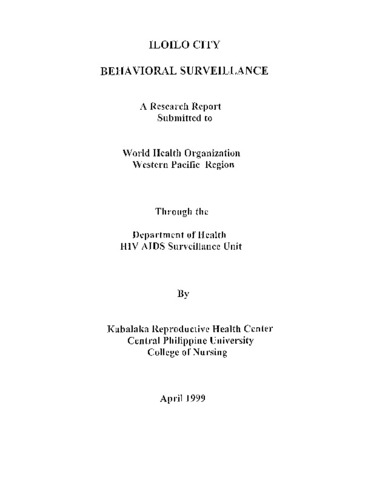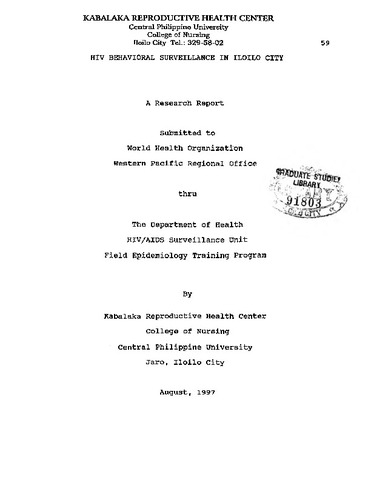| dc.description.abstract | This research study was conducted to determine the profile, abuse experience and health outcomes of sexually abused women and children referred and examined at the Women and Child Protection Unit (WCPU) of Western Visayas Medical Center from June 2005 to June 2007. Specifically, the study aimed to describe the profile of the sexually abused women and children in terms of age. sex. civil status and location of residence; the abuse experience as to type, episode and time of reporting abuse, the relationship and number of perpetrator of the abused and the physical, reproductive and psychologic health outcomes of sexual abused victims. A descriptive retrospective study, a total enumeration of 553 cases of sexually abused clients seen and examined at the Women and Child Protection Unit (WCPU), Department of Obstetrics - Gynecology and who were subsequently referred to the Department of Psychiatry was done. Descriptive statistics was utilized using frequency distribution and cross tabulation. Results of the study showed that sexually abused victims were predominantly 12-17 years old who were in their adolescence stage. They were predominantly female, single and were residing outside Iloilo City. The predominant type of abuse experienced by the victims was forced sexual intercourse with majority being committed against them by people associated to them, either as neighbor, boyfriend, friend, and employer. The Relatives followed, with the uncle, father, cousin, grandfather and other relatives as offenders. The victims had predominantly single episode and single perpetrator at a given time. Reporting of abuse were mostly delayed with the majority reporting the abuse more than 72 hours after it occurred.
Health Outcomes of the abuses were categorized as physical, reproductive and psychologic in nature. The most common physical outcome experienced by the victims was bodily pain of various forms as the most often complained about. The common reproductive outcomes as consequences of the abuse were pregnancy and Sexually Transmitted Infections (STI), such as STI-Unspecified, Gonorrhea, Hepatitis B, Syphilis, Trichomoniasis and Fungal Infections.
Of those cases referred to the Department of Psychiatry with patient records available at the WCPU and who were diagnosed of a psychologic outcome, the most predominant diagnosis was Post-Traumatic Stress Disorder (PTSD). There is no difference in the type of sexual abuse when grouped according to relationship of perpetrator. Whether known as associates or the nearest blood relative /kin, forced sexual intercourse was still the most predominant offense. There was no specific type of sexual abuse to a certain perpetrator, whatever the relation maybe with the victims. There was a difference in the type of sexual abuse when grouped according to age, sex, and civil status. Forced sexual intercourse was the predominant type of abuse among all the age groups except for the six year olds and below. The female population was at higher risk for forced sexual intercourse while the male population was at higher risk for sexual assault. The single population was of highest risk for all types of sexual abuse, whether forced sexual intercourse, sexual assault, and mixed type (forced sexual intercourse with physical abuse/sexual assault with physical abuse). The health outcomes differed according to age group, sex, and civil status while physical outcomes were common in all age groups. It was the 12-17 years old who sustained most physical, reproductive and psychologic outcomes. The female and single population had the most number with health outcomes, whether, physical, reproductive or psychologic in nature.
Forced sexual intercourse resulted to all physical, reproductive and psychologic outcomes. There is difference in the health outcomes when grouped according to type of sexual abuse and study results revealed an association between the health outcomes and the type of sexual abuse. Sexual abuse remains a gender-based violence with women and children victimized because of sex-role stereotyping and the cultural belief of a male-dominated society which still looked upon them as the “weaker vessel”, an object of sexual pleasure and satisfaction. With this, women and children are high risk for victimization. The finding in this study which identified the adolescents as the most at risk for sexual violence indicates that their individual and uniqueness contributed to their victimization. Their growth and developmental issues are of utmost consideration.
Sexual violence in various forms are perpetrated by people who are dominant and maintain a position of authority over the women and children victims. These people abuse their power over those that are physically, emotionally weak to fight against them. Sexual abuse by trusted people who are in the persons of neighbors, relatives can cause terrible pain from the betrayal and loss of innocence. In relation to delayed reporting of sexual abuse, it can be deduced that sexual abuse while a horrific crime that can cause traumatic stress to the victims and their loved ones, it remains underreported. While threat to own life and fear of endangering safety of loved ones maybe reasons, most victims opt to remain silent. Sexual abuse to a certain extent, is a private, domestic secret of the individual victim and the family. Further, delayed reporting may result to delayed detection of physical, reproductive and psychologic outcomes. Hence, treatment when required may also be delayed and health outcomes compounded.
Forced sexual intercourse as a form of sexual violence can happen to anyone across the life span, however, the more reproductive mature, predominantly single, female victims suffer from most health outcomes.
Health and illness are influenced by various factors. Using Stuart’s Model, predisposing factors such as age group, sex, and civil status influenced their ability to handle stress, confront or rendered them vulnerable the precipitating stressor, which was the abuse experience, eventually resulted to health outcomes, whether physical, reproductive or psychologic in nature. The younger the victim and less reproductive ready, the more physical outcomes were reported while the more reproductively prepared but less emotionally stable had more reports of reproductive and psychological outcomes.
The type of sexual abuse to a certain extent, influenced the type of health outcomes that the victims experienced which are consistent with documented cases in related studies. Also, the health outcomes vary according to type of sexual abuse and xvii there is an association between the type of sexual abuse and there is an association between the type of sexual abuse and the type of health outcomes that developed among the victims. | en_US |





